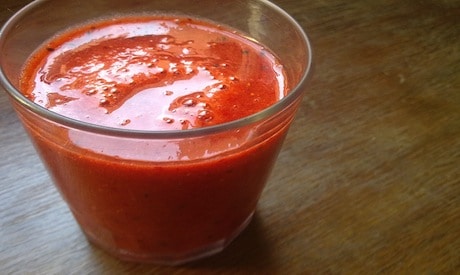
Juicers are a passionate bunch. From spinach to kale, lemon, carrot, ginger and everything in between, they often make trips to the farmers market or grocery store nearly every day. Blending a smoothie, on the other hand, is less intimidating, because fruits and vegetables hold their volume, and therefore, it takes fewer of them. But which is the better option: Juicing or Blending?
We often fall on one side or the other of the juicing versus blending debate. Juicers may be obsessed with their “daily medicine,” while smoothie lovers think blending is the only way to go. Let’s take a closer look:
Juicing: Pros and Cons
Juicing extracts all of the water and nutrients from produce, leaving behind plant fibers and seeds. Juicers believe that the body is better able to absorb nutrients and you can fit a larger quantity of fruits and vegetables in one cup of juice. Without the fiber, juicing gives your digestive system a rest so it doesn’t have to work as hard breaking foods down. With the seeds and pulp juiced out, juicers contend that there’s no bitter after taste.
But juicing is inherently expensive, first considering the cost of the juicer itself, which range from $60 to $400, and then considering the myriad of fruits and vegetables needed to make daily juices. Juicing also takes a lot of time because not only do you have to make juice, you have to clean the juicer thoroughly after every use to prevent rusting. It’s a real commitment.
Removing the fibrous portion of produce is positive because you absorb more nutrients, but it’s negative because juice isn’t very filling. You’ll get hungrier faster than you would with a smoothie. The juice goes straight to your blood stream so if you juice too many fruits or sweeter vegetables, you may experience a spike in your blood sugar. Unstable blood sugar is responsible for mood swings, energy loss, and even memory problems.
Blending: Pros and Cons
Blending finely chops fruits and vegetables, skin and all, into a smooth consistency. With a smoothie, your digestive system does have to work a little harder breaking down and absorbing nutrients, but you’ll feel fuller longer than you would with a juice. On the other hand, you won’t be absorbing as many nutrients as you would in a juice.
Read more about the healthiest fruits and vegetables
Both juicing and blending change the original form of fruits and vegetables, but smoothies only require a simple blender that you likely already have on hand.
After fruits and vegetables are broken down in the process of juicing or blending, they immediately lose vitamin C and antioxidants when they make contact with oxygen. In other words, both fresh juices and fresh smoothies need to be enjoyed immediately to avoid significant nutrient loss.
Bottom line–If you want more nutrient bang for your buck, consider juicing. And if ease and budget are a concern, stick with smoothies. Or you can love and enjoy them both for what they bring to the nutritional table.
Image: Lablascovegmenu










